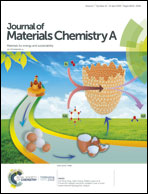Polysulfide-driven low charge overpotential for aprotic lithium–oxygen batteries†
Abstract
Developing Li–O2 batteries with high-rate and long-cycle performance remains a major challenge due to the high charge overpotential induced by the insulating discharge products of Li2O2. Herein, we develop a strategy to achieve high-rate and excellent cycle performance Li–O2 batteries by introducing sacrificial lithium polysulfide in aprotic electrolyte to realize ultralow charge overpotential, where the discharge products of Li2O2 have been replaced with lithium thiosulfate. In a demonstration study using Li2S6 during the discharge process, O2 receives electrons and reacts with Li2S6 to form thiosulfate intermediates, which further accept electrons and convert Li2S6 to Li2S2 and Li2S4O6. The charge process is divided into three stages: the oxidation of low-order lithium polysulfide to high-order polysulfide, Li2S2O3 to Li2S4O6, and high-order polysulfide to sulfur, respectively, resulting in low charge overpotential. Despite gradual consumption of Li2S6 by the solvent, the electrochemical performance significantly increases. At a high current density of 0.5 A g−1, the battery with CNTs as the cathode and Li2S6 as the electrolyte additive demonstrates an excellent cycle performance of 147 cycles with a low initial charge overpotential of 0.19 V at a fixed capacity of 500 mA h g−1. This study provides a promising strategy to design high-rate and long-cycle performance of Li–O2 batteries by altering the discharge products.



 Please wait while we load your content...
Please wait while we load your content...